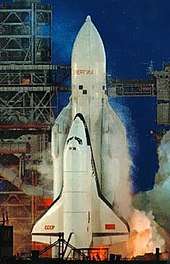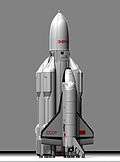Buran (spacecraft)
| Buran Буран | |
|---|---|
|
Orbiter 1K1 at the 1989 Paris Air Show. | |
| Country | |
| Named after | "Snowstorm"[1] |
| Status | Destroyed in a 2002 hangar collapse[2] |
| First flight | 15 November 1988[1] |
| Last flight | 15 November 1988[1] |
| No. of missions | 1[1] |
| Crew members | 0[1] |
| Time spent in space | 3 hours, 25 minutes, 22 seconds |
| No. of orbits | 2[1] |
Buran (Russian: Бура́н, IPA: [bʊˈran], meaning "Snowstorm" or "Blizzard"; GRAU index serial number: "11F35 K1") was the first spaceplane to be produced as part of the Soviet/Russian Buran programme. It is, depending on the source, also known as "OK-1K1", "Orbiter K1", "OK 1.01" or "Shuttle 1.01". Besides describing the first operational Soviet/Russian shuttle orbiter, "Buran" was also the designation for the whole Soviet/Russian spaceplane project and its orbiters, which were known as "Buran-class spaceplanes".
OK-1K1 completed one unmanned spaceflight in 1988, and was destroyed in 2002 when the hangar it was stored in collapsed.[3] It remains the only Soviet reusable spacecraft to be launched into space. The Buran-class orbiters used the expendable Energia rocket, a class of super heavy-lift launch vehicle.
Construction
The construction of the Buran-class space shuttle orbiters began in 1980, and by 1984 the first full-scale orbiter was rolled out. Construction of a second orbiter (OK-1K2, informally known as Ptichka) started in 1988. The Buran programme ended in 1993.[4]
Operational history

Orbital flight
The only orbital launch of a Buran-class orbiter occurred at 03:00:02 UTC on 15 November 1988 from Baikonur Cosmodrome launch pad 110/37.[3][5] Buran was lifted into space, on an unmanned mission, by the specially designed Energia rocket. The automated launch sequence performed as specified, and the Energia rocket lifted the vehicle into a temporary orbit before the orbiter separated as programmed. After boosting itself to a higher orbit and completing two orbits around the Earth, the ODU (Russian: объединённая двигательная установка, сombined propulsion system) engines fired automatically to begin the descent into the atmosphere, return to the launch site, and horizontal landing on a runway.[6]
After making an automated approach to Site 251 (known as Yubileyniy Airfield),[3] Buran touched down under its own control at 06:24:42 UTC and came to a stop at 06:25:24,[7] 206 minutes after launch.[8] Despite a lateral wind speed of 61.2 kilometres per hour (38.0 mph), Buran landed only 3 metres (9.8 ft) laterally and 10 metres (33 ft) longitudinally from the target mark.[8][9] It was the first space shuttle to perform an unmanned flight, including landing in fully automatic mode.[10] It was later found that Buran had lost only eight of its 38,000 thermal tiles over the course of its flight.[9]
Projected flights
In 1989, it was projected that OK-1K1 would have an unmanned second flight by 1993, with a duration of 15–20 days.[11] Although the Buran programme was never officially cancelled, the dissolution of the Soviet Union led to funding drying up and this never took place.[4]
Destruction

On 12 May 2002,[3] during a massive storm at the Baikonur Cosmodrome in Kazakhstan, the MIK 112 hangar housing OK-1K1 collapsed as a result of poor maintenance. The collapse killed eight workers and destroyed the craft as well as an Energia carrier rocket.[12][13][14]
See also
- OK-GLI – Buran Analog BST-02 test vehicle
- Mikoyan-Gurevich MiG-105 – Soviet orbital spaceplane
- Space Shuttle program (United States)
References
- 1 2 3 4 5 6 "Buran". NASA. 12 November 1997. Archived from the original on 4 August 2006. Retrieved 15 August 2006.
- ↑ "Eight feared dead in Baikonur hangar collapse". Spaceflight Now. 16 May 2002.
- 1 2 3 4 "Buran". Russian Space Web. 15 October 2012. Archived from the original on 15 February 2015. Retrieved 28 September 2013.
- 1 2 Wade, Mark. "Buran". Encyclopedia Astronautics. Archived from the original on December 20, 2008. Retrieved December 20, 2017.
- ↑ "S.P.Korolev Rocket and Space Corporation Energia held a ceremony..." Energia.ru. 14 November 2008. Retrieved 3 September 2016.
- ↑ Handwerk, Brian (12 April 2016). "The Forgotten Soviet Space Shuttle Could Fly Itself". National Geographic Society. Retrieved 12 April 2016.
- ↑ "Buran: 1st Flight". Buran-Energia.com. Retrieved 20 March 2017.
- 1 2 Chertok, Boris (2005). Siddiqi, Asif A., ed. Raketi i lyudi [Rockets and People] (PDF). History Series. NASA. p. 179.
- 1 2 "Russia starts ambitious super-heavy space rocket project". Space Daily. 19 November 2013. Retrieved 13 December 2013.
- ↑ "Largest spacecraft to orbit and land unmanned". Guinness World Records. Retrieved 10 March 2017.
- ↑ "Экипажи "Бурана" Несбывшиеся планы". Buran.ru (in Russian). Retrieved 5 August 2006.
- ↑ Whitehouse, David (13 May 2002). "Russia's space dreams abandoned". BBC News. Retrieved 14 November 2007.
- ↑ "Buran.ru: Photo of collapsed hangar".
- ↑ Buran.ru: Remains of Buran photo with right front windscreen still visible under the debris
Further reading
- Hendrickx, Bart; Vis, Bert (2007). Energiya-Buran: The Soviet Space Shuttle. Springer-Praxis. p. 526. ISBN 978-0-387-69848-9.
- Elser, Heinz; Elser-Haft, Margrit; Lukashevich, Vladim (2008). History and Transportation of the Russian Space Shuttle OK-GLI to the Technik Museum Speyer. Technik Museum Speyer. ISBN 978-3-9809437-7-2.
External links
| Wikimedia Commons has media related to Buran (spacecraft). |
- Buran.ru
- Buran-Energia.com
- Buran schematic diagram
- Photos from the abandoned Buran facilities at Baikonur by Ralph Mirebs
- Photos of the destroyed Buran orbiter at Aviationweek.com

